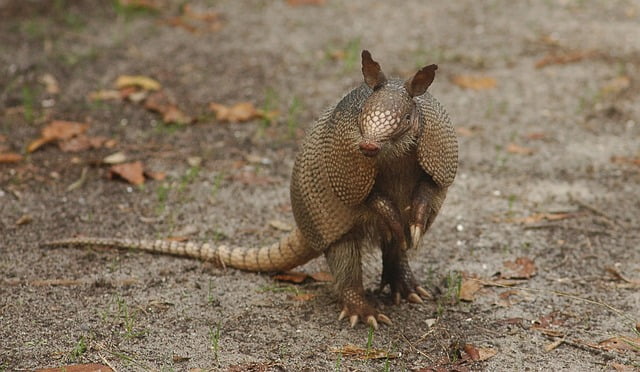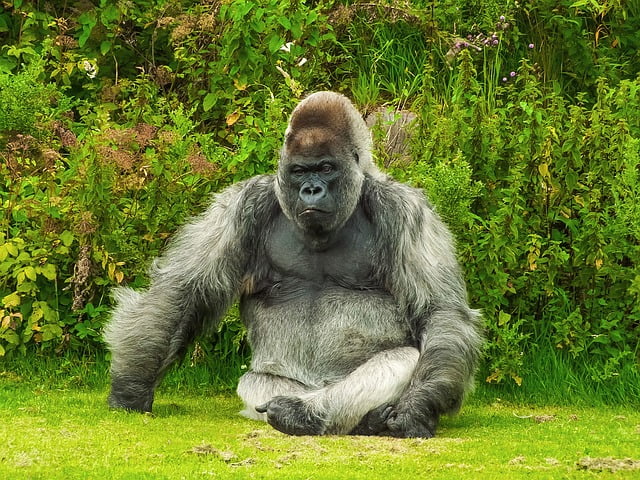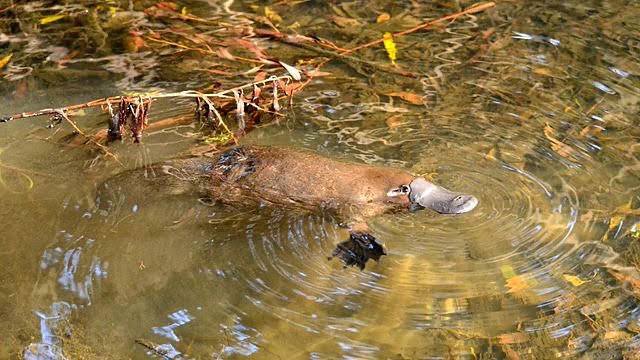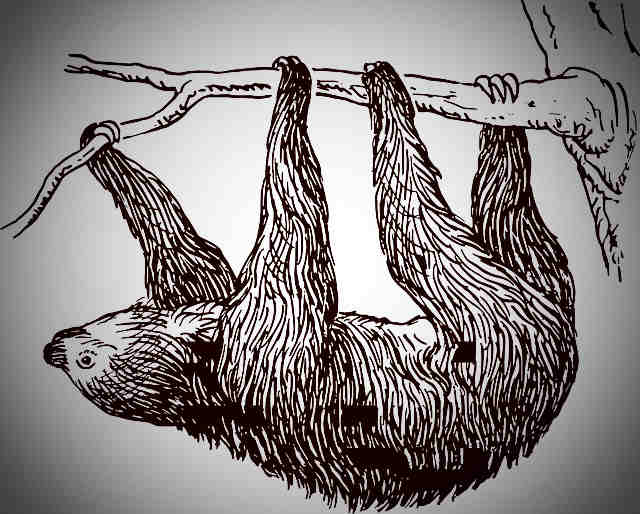Marsupials are mammals that give birth to an altricial young to be nursed inside a pouch. Sloths are definitely not one of them!
Are sloths marsupials?
Sloths are not marsupials. The living class of animals called “Mammalia” exist in three major clades which includes; monotremes (mammals that lay eggs), marsupials (mammals that give birth to an early stage fetus) and placentals (mammals that give birth to fully developed fetus).
Sloths belong to the “placental” group, which means that they give birth to their young ones at a more advanced developmental state, just like humans.
Brief, classification of living organisms
The class mammalia is made up of numerous extinct lineages as well as three extanct clades: the marsupials, montremes and placentals.
The class itself is a subset of a group called chordate, which in turn is a subset of a bigger group called animalia, which in turn belongs to an even bigger group called the eukaryotic domain.
In a neat and arranged fashion, it looks something like this:
Domain (eukaryoutes) >> Kingdom (animalia) >> Phylum (chordate) >> Class (mammalia).
This way of grouping living organisms is known as biological taxonomy and it helps biologists and scientists to better understand the diversity among living organisms (to say the very least).
The highest level on the hierarchy (domain) classifies living organisms based on some basic shared characteristics i.e. their cell structure and how they obtain their food, while the smaller groups are based on more detailed similarities within each larger group i.e. anatomic and reproductive similarities, intra breeding capabilities and so on.
So, living organism of that share the same lower taxonomical rank are always strict relatives of one another compared with other organisms they share the preceding larger group with. And so on and so forth.
The modern taxonomical classification system consists of 8 main levels which include:
Domain >> Kingdom >> Phylum >> Class >> Order >> Family >> Genus >> Species (in the hierarchical order). Note that this system is one of the many arrangement proposed and is not impervious to change.
Several other intermediary groups also exist within these major groups, for example, the phylum chordate has a sub-phylum (vertebrate) which includes all living organisms (under phylum chordate) that posses a vertebral column (i.e. mammals and their closest relatives). Another sub-phylum within the main phylum group is the sub-phylum (invertebrate), which consists of all living organisms without a vertebral column.
The three major groups of the mammalia class
Marsupials, Monotremes and Placentals form the three major groups of the mammalia class. They are the only three extant groups of this class where all other remaining groups have members that are extinct.
These three groupings classify all living mammals largely based on their reproductive pattern, although several other peculiarities exist to distinguish members of one group from the other.
What are marsupials?

Marsupials are ancient group of mammals that originated in the Late Jurassic about 165 – 145 million years ago.
They were one of the most dominant groups of mammals during that period and today they form the second most diverse clade of living mammals after Placentalia ( there are approximately 334 species of marsupials identified today; Armati et al. 2006).
Marsupials are mammals that give birth to their young ones in an underdeveloped state after a relatively brief period of gestation; about 8- 43 days depending on the species. Lillegraven (1975) claimed that this mode of reproduction is necessary for the survival of the developing embryo since allowing the baby embryo to live in the mothers womb for any longer could result in the immune recognition and rejection of the fetus.
This claim relates that marsupial mammals have not evolved the reproductive ability to prevent immunological rejection of young by the mother.
After the embryos are born, they crawl away from the mothers reproductive canal to her nipples (or teats) which are “often” but not always located in a pouch outside of her body, usually her up on her ventral side (as in the case of kangaroos and koalas) but can also be sloped backwards and downwards with an opening near the tail region (as in the case of bandicoot and Tasmanian devil).
Then, they latch onto them (the teats) with their mouth begin to suckle from the squirting milk and continue to develop for weeks or months depending on the species.
The term “marsupial” comes from the latin word “marsupium”, “marsuppium” which means “pouch” or “purse”. Modern marsupial mammals include; opossums, kangaroos, koalas, bandicoots, Tasmanian devil, wombat, numbat and several other species.
Today, most marsupials are abundant and structurally diverse in Australia, South America and Central America, although fossil record shows that they were once more widespread. They are also the most dominant species of mammals in a single continent; Australia.
What are placentals?

Placental mammals are the largest and most diverse clade of living mammals. Nearly 95% of all modern mammals species belong to this group.
They have history dating back as far as the Late Crecatous, which is about 170 million years ago. They consist of more than 4000 animal species and can be found nearly on all landmasses and in every ocean of the world.
Placental mammals give birth to their young ones in a more advanced developmental stage; which means their young ones are born anatomically complete.
Their gestation period is relatively longer compared to marsupials and can vary from few months to two years depending on the species.
The embryos of placental mammals are nourished before birth in their mothers uterus through a specialized organ called the placenta.
The placenta connects the embryo to the mother and allows for nutrient and gas exchange, waste elimination, thermo-regulation, and also serves as an immunological barrier between mother and fetus, there by protecting the child from the mothers natural immune response.
Once born, the mammal undergoes a relatively short period of lactation where it fully depends on its mother for milk and protection.
Placentals differ from their clad sisters “marsupials” in that they have evolved the ability to prevent immunological recognition and rejection of their young by the mother (the placenta partly helps with this).
The name “placenta” is derived from the name given to the dominant extraembrayonic structure (the placenta) found in the group.
The word comes from the latin word “placenta” which means, “flat cake”, because of the flat round shape of the after birth. Modern placental mammals include sloths, humans, dogs, cats, lions, armadillos, monkeys, apes, and all other related species.
Today, most placental mammals can be found everywhere on earth from land, air to the waters.
What are monotremes?

Monotremes are the primitive clade of the mammalia class. They have fossil history dating as far back into the Late Jurrasic which is about 163 – 145 million years ago.
They are less diverse compared to the other living clades and only five living species of them are extant today (spread across two families).
Monotremes differ from marsupials and placentals in the sense that they lay eggs instead of birthing their young ones alive.
Their eggs are small, few and soft shelled and when the babies hatch (around 10 days after they have been laid and incubated on) they suckle or more correctly, they lick milk from pores squirting milk on their mothers underside untill they become independent enough to feed themselves (around 3-5 months old).
The name “monotremes” stems from the fact that they have only one body opening for both excretion and reproduction.
Modern monotreme mammals include four species of platypus and one specie of echidnas distibuted in the geographic region of Australian and New Guinea.
In addition
Under each group of the three mammalian clades discussed above, there exists further classifications (just as pointed out earlier) which continues to narrow down until the lowest species level.
Here, all the mammals that share the same specie group are directly related to one another with only very little variations here and there.
Sloths for example, belong to the Superorder Xenarthra (which is one of the three major clades of placental mammals native to the Americas and distinguished by their strange joints), Order Pilosa (all living Xenanthras that are hairy in nature; which included all sloths and anteaters), and the families Bradypodidae; the three fingered sloths and Choloepodidae; the two fingered sloths.
The genera for Bradypodidae is Bradypus while that for Choloepodidae is Choloepus.
The four extant species of the Bradypus genera include:
- Pygmy three fingered sloth (Bradypus pygmaeus).
- Brown throated three fingered sloth (Bradypus variegatus).
- Pale throated three fingered sloth (Bradypus tridactylus).
- Maned three fingered sloth (Bradypus torquatus).
The two extant species of the Choloepus genera include:
- Linnaeus’s two fingered sloth (Choloepus didactylus).
- Hoffmann’s two fingered sloth (Choloepus hoffmanni).
Similarities between marsupials and placentals
- They are both mammals; they have hair, mammary glands: part of which functions to produce milk for suckling their newborn offsprings, three middle ear bones, four chambered heart, backbones and warm-blood (endothermic), among many others peculiarities.
- They both give birth to their young ones alive.
- They both have placentas (but are structurally and functionally different): The placenta in marsupials is rudimentary and does not produce as many hormones to sustain itself or provide as long a period of sustenance for the developing embryo, unlike those found in placental mammals, which is able to provide nutrients and immune protection for the embryo until birth.
Differences between marsupials and placentals
The differences below are pointed out with respect to the titling: (marsupials to the left and placentals to the right)
- Birth of underdeveloped young vs anatomically complete young.
- Well developed placenta vs rudimentary placenta.
- No belly buttons vs belly buttons.
- Inner pouch for nursing young vs nursing of young outside the body.
- Smaller and tighter skulls vs larger and more loose skulls.
- Marsupials have different number of incisors (except for wombats) on both upper and lower jaw than placental mammals.
- Up to three vaginas in females (the median one being the birth canal that form prior to birth) vs one vagina in females.
- Two uteri in females vs one uteri in females.
- Double penis in front of scrotum of males vs single penis in front of scrotum of males.
- Longer lactation vs relatively shorter lactation.
- Shorter gestation vs relatively longer gestation.
- Less investment in energy and time for pregnancy vs high investment in energy and time (this is due to the fact that placental mammals bear their young ones internally and must themselves selectively feed on more costly but highly nutritious food to nourish their young)
More interesting sloth articles:
Obsessed with sloths? Check out our sloth category to learn more about them:
Reference
i) Williamson, T. E., Brusatte, S. L., & Wilson, G. P. (2014). The origin and early evolution of metatherian mammals: the Cretaceous record. ZooKeys, (465), 1–76. https://doi.org/10.3897/zookeys.465.8178
Cite this Article ” (APA Format)
Bunu. M. (2020, March 22). Are sloths marsupials?. Retrieved from http://emborawild.com/are-sloths-marsupials/

